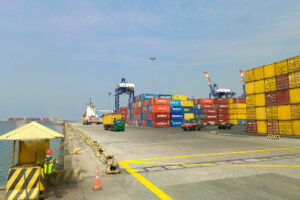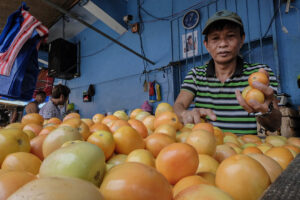Export diversification has long been a strategy pushed to maximize space for our goods and services to grow, thus, in part generating more business and gainful jobs at home.
This thrust has been a key push in the country’s export development plans, including the one covering 2023-2028. Geopolitical tensions, however, have made this thrust more imperative, and urgent.
Household consumption has been the Philippine economy’s biggest driver, accounting for about three-fourths of gross domestic product. In comparison, government spending makes up just more than a tenth.
And despite observations that the Philippines is less imbedded in global value chains than many of its neighbors, foreign trade of goods and services contribute significantly to national output, with exports accounting for more than a fourth and imports, more than 37%.
NOTHING NEW, BUT…Official foreign trade in goods data show that China was the Philippines’ top partner in 2023, accounting for a fifth of a $199.826-billion total value. It was followed by Japan at far second with 10.4% and the United States in third place with 10%. Hong Kong was sixth after Indonesia (6.1%) and South Korea (6%) with 5.4%, but let’s not forget that the former British colony remains China’s special administrative region where the Communist Party’s directives are enforced swiftly and rigorously (leading some analysts to combine China and Hong Kong data for the sake of discussion).
In terms of merchandise exports, China placed a close second to the US (15.7% of the $73.617-billion total) with 14.8% last year, but topped Philippine import sources with 23.3% (of a $126.209-billion 2023 total). Indonesia placed a far second with just 9.1% of total Philippine imported goods, followed by Japan (8.2%) as well as Korea and the US with 6.7% each.
It does not take an expert to realize that such heavy reliance on one country poses a big risk to the economy. Yes, the Philippines will likely catch a cold if China sneezes, but even more so should the Middle Kingdom tighten the screws on its vulnerable southeastern neighbor.
I don’t know if planners in the government and the export sector have specific diversification targets up to 2028, but fast-rising geopolitical tensions in our corner of the world have just made this push much more vital than ever for our economic security (meaning it can no longer be business as usual for this trade imperative).
I am not so naive to think that China is the only power that has been wont to weaponize non-military activities like trade, aid, and investments.
But the problem is that China seems to have singled out the Philippines — the weakest in this region in terms of defense — to serve as an example for other Southeast Asian claimants to parts of the South China Sea.
And Beijing has certainly not been hesitant to wield economic clout for political ends. Recall, for example, how Mindanao exporters in 2012 blamed the Scarborough Shoal maritime deadlock with China back then for sudden quarantine hurdles there for Philippine bananas. And more recently, Beijing had responded to Canberra’s call for an independent inquiry on the origins of the COVID-19 virus with wide-ranging sanctions on Australian products, at a time when China was estimated to account for nearly 40% of Australia’s exports. A November 2021 article in Foreign Policy magazine noted that other markets that had borne the brunt of Beijing’s “trade coercion” at one time or another include Canada, Japan, Lithuania, Mongolia, Norway, South Korea, and Taiwan.
SWORD OF DAMOCLESWhile there seems to be no sign for now that Beijing is about to tighten the economic screws just yet (with decreasing Chinese tourists attributed more to households scrimping as China’s economy slows) — perhaps in hopes of persuading Manila to be more pliable in the West Philippine Sea — that could change overnight, and soon.
A Sept. 9 Reuters article quoted a commentary in the People’s Daily, the Communist Party’s mouthpiece, as warning that “China-Philippines relations stand at a crossroads,” adding that bilateral “[d]ialogue and consultation” — Beijing’s preferred method for resolving disputes (a tack that can be especially effective in pressuring individual smaller countries) — “is [sic] the right path, as there is no way out of the conflict through confrontation (like ramming our ships and dropping flares ahead of our planes, both of which are unacceptable behavior under international safety rules?)” The same piece said that Manila “should seriously consider the future of China-Philippines relations and work with China to push bilateral relations back on track.”
That makes any potential economic sanction from China a sword of Damocles hanging over our head as a country.
China’s lure may be due to the sheer size of that market plus personal ties there of a number of our businessmen, but perhaps it’s time for a more spirited push to explore prospects that are less risky for us.
Because it may just be a matter of time before Beijing decides to pull this trigger.
We may take a page from the playbook of Australia, which weathered China’s trade sanctions through “trade diversion.” “When a trade barrier is erected, businesses seek alternate outlets for their products. In open international markets, the outcome is rarely the destruction of export industries. Most of the time, trade flows adjust around the barrier,” wrote Jeffrey Wilson, research director of Perth USAsia Centre, in “Australia shows the world what decoupling from China looks like” in Foreign Policy magazine, Nov. 9, 2021.
TAKE A SECOND LOOKSenen M. Perlada, executive vice-president and chief operating officer of the Philippine Exporters Confederation, Inc. as well as former executive director of the Export Development Council for more than 16 years, said in a recent chat that markets that could be targeted as we pivot partially away from China (as the global chief executive of a luxury goods multinational once told me, “Let’s be realistic: there is no decoupling from China”) include Japan, South Korea, Hong Kong, Taiwan, and Vietnam, as well as those in the rest of Southeast Asia, the European Union (EU), the US, Canada “and even EFTA” (European Free Trade Association members Iceland, Liechtenstein, Norway, and Switzerland).
He also cited the need to tap “the unrealized potentials of Philippine exports” in preferential trade area schemes (PTAs) such as the EU GSP+, the US Generalized System of Preferences, the United Kingdom’s Developing Countries Trading Scheme, and Canada’s General Preferential Tariff; the Regional Comprehensive Economic Partnership; as well as regional free trade agreements (FTAs) like those which ASEAN has with China, Hong Kong, India, Japan, South Korea, and New Zealand. The Philippines also has bilateral preferential deals like the Philippines-Japan Economic Partnership Agreement and the Philippines-European Free Trade Area Free Trade Agreement. The latest export development plan outlines all these potentials.
The problem, however, is that a number of Philippine exporters have been struggling to meet exacting standards like those of the EU, so both the government and foreign business chambers have programs to upgrade local exporters’ capabilities to enable them to tap existing potentials. “The DTI (Department of Trade and Industry) has existing programs such as educating our exporters and promoting the utilization of our PTAs, bilateral and regional FTAs and the focus can be shifted to opportunities other than those in China to alternative markets,” Mr. Perlada said. Whether these targeted programs have borne fruit in terms of a perceptible increase in our exports to those markets remains to be seen.
The Philippines also suffers merchandise trade deficits with a number of major partners, including China ($18.467 billion last year), Indonesia ($10.766 billion), South Korea ($4.954 billion), and Thailand ($4.949 billion), among other markets, pointing the way for our exporters to widen their reach.
JUST IN CASE…One major market that could offer bright potentials, for example, is India, the Philippines’ 15th biggest trade partner last year with which we had an $876.14-million trade gap in 2023. “Existing… potential has not been realized and there is need to further facilitate trade between the two countries especially since both economies are growing and are complementary to each other,” says the website of India’s embassy in the Philippines.
India has lately shown more interest in geopolitical developments in the South China Sea (a major global trade route and regional fishing ground), itself having fought border clashes with China and which is facing intensified efforts by Beijing to build and flex its influence in the Indian Ocean.
That makes us natural allies and partners in more ways than one.
But while India’s population is estimated to have matched that of China at 1.426 billion last year, its mass market may not be as complementary to the Philippines as that of China, at least according to initial observations. Thus, Mr. Perlada said, it may be a better bet for now to push creative industries and high-value goods and services and not consumer items if we are to ramp up trade with that South Asian giant, which has been among the fastest-growing large economies in the world (yes, much faster than the likes of China and Vietnam, with economic growth outpacing the increase of its population). “For purposes of broadening and deepening the engagement with India, perhaps it may be worthwhile deploying more trade service officers in India, which is such a large and diverse country,” he said.
Besides widening the reach of Philippine goods abroad by identifying untapped but promising markets, Mr. Perlada also cited the need to develop more small- and medium-sized exporters by providing accurate information and practical insights on alternative markets, more resources for export promotion activities like business matching missions and trade fairs, as well as lowering regulatory hurdles, among others.
“The use of resources needs to be revisited and adjustments in trade policy and promotion efforts have to be updated and rationalized. The recommendations and action points in the Philippine Export Development Plan should be provided with resources so the same can be executed,” he said.
In the meantime, it may be prudent to prepare for the worst-case scenario. While it may not come to that (fingers crossed), it certainly wouldn’t hurt to ready a backup plan to support industries (starting with semiconductor and electronics, which have accounted for more than half our exported goods, a chunk of which goes to China) that could take a hit should Beijing’s aggression against the Philippines suddenly spill over into the economic front.
Wilfredo G. Reyes was editor-in-chief of BusinessWorld from 2020 through 2023.















